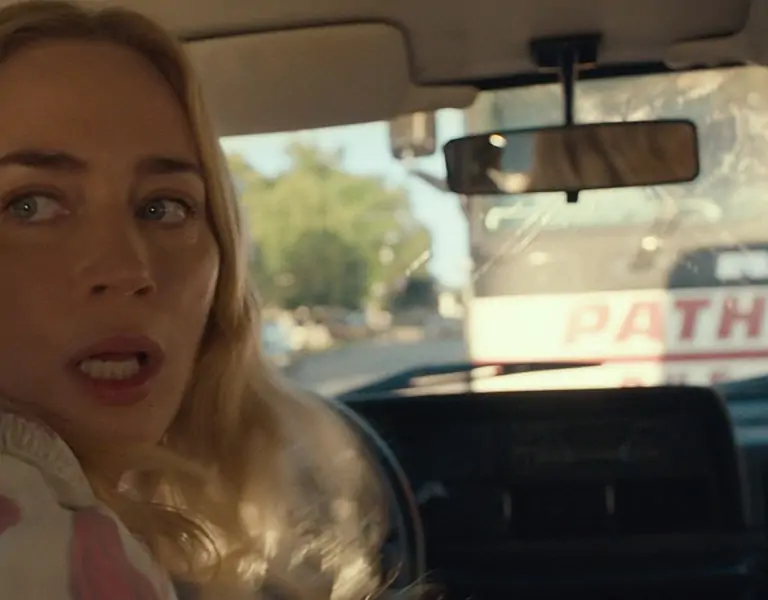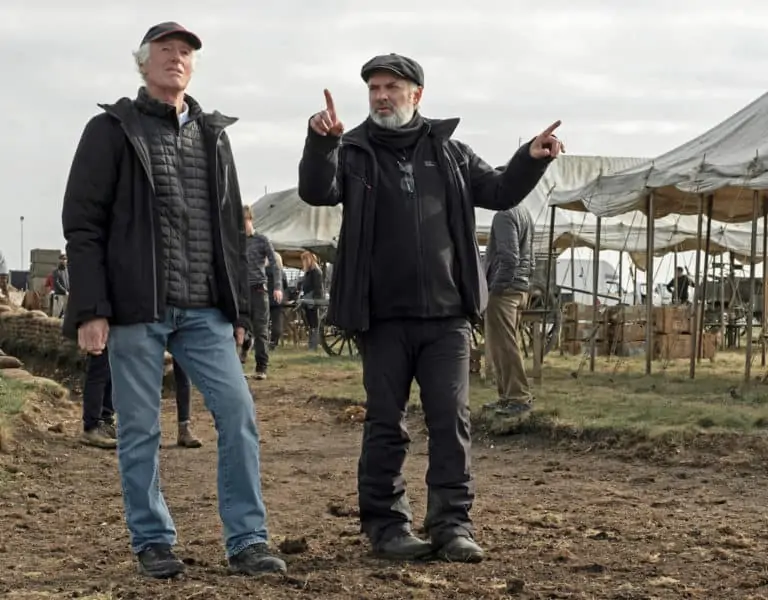MYSTERY IN THE MARSHES
Bringing a much-loved book to the screen saw Polly Morgan BSC ASC reconnect with a love for nature that blossomed in childhood, brave the elements, and embrace a lyrical visual approach to tell the gripping tale of resilience.
Growing up in a remote part of the UK, Polly Morgan BSC ASC spent much of her childhood walking in the woods, sitting on riverbanks, and discovering the natural world alone. Making up stories as she explored the countryside fostered the imagination and creativity that helped the cinematographer develop into the storyteller she is today.
In the summer lockdown of 2020, Morgan read Where the Crawdads Sing – Delia Owens’ murder mystery about a young girl who forms a strong connection with nature while growing up isolated in the marshes of 1960s North Carolina – and felt an instant bond with the protagonist.
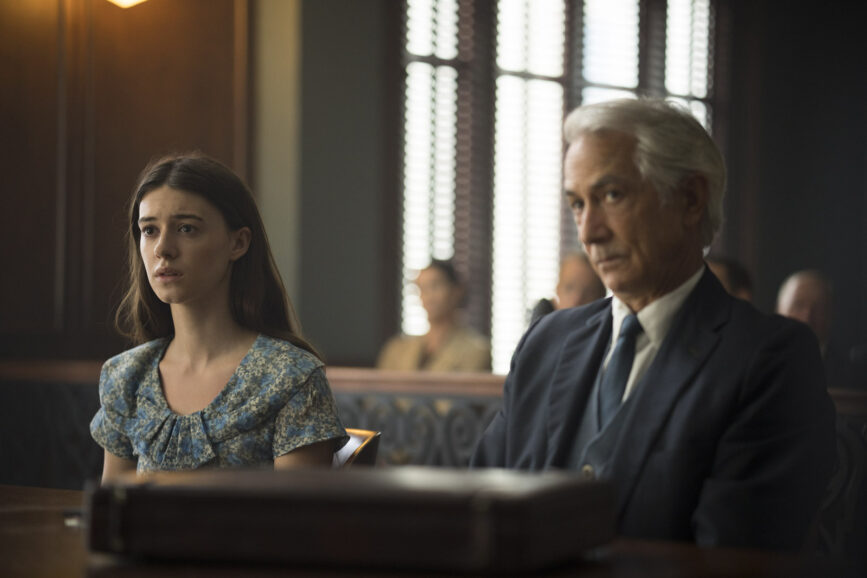
“The story resonated with me and then I was excited when my agent, Tara Kromer, told me the book was going to be translated for the screen. However, the studio execs already had a list of DPs they thought were right for the project and my name wasn’t on it, perhaps because they hadn’t seen any nature in my previous work,” she says.
After finding the director Olivia Newman’s email, Morgan wrote to her explaining why she loved the book, and it culminated in a meeting in which the pair shared ideas and discussed the remarkably similar look books they had compiled.
“Images speak a thousand words, and it was immediately clear we saw in the same way. After Zoom calls with producers from Hello Sunshine and 3000 Pictures – an arm of Sony – I was offered the job. I was so overwhelmed and excited,” says Morgan. “Kya’s story is a tale of resilience. This young girl is dealt a miserable hand but is determined not to let anything get in her way. I always felt like that, and I saw a lot of her in me. I had a tenacious grip on my goals and dreams as a young woman and was resolute to realise them.”
While Morgan and Kya are alike in their determination and connection to nature, the novel’s narrative moves in a gripping and at times bleak direction as a murder mystery plays out that has seen the page-turner become one of the best-selling books of all time. Abandoned as a child and then forced to raise herself in the marshlands, recluse Kya’s eyes are opened to a new world when two young men, Chase and Tate, come into her life. When one of them is found dead, Kya becomes a prime suspect in the murder.

Lyrical lensing
Frames from productions using “lyrical cameras to create beautiful images” became Newman and Morgan’s references; from the work of Terrence Malick in The New World, Days of Heaven, and Badlands to Greig Fraser ASC ACS’s lensing of Jane Campion’s Bright Star (2009) and through to Bradford Young ASC’s work on David Lowery’s Ain’t Them Bodies Saints (2013).
The filmmakers decided that – like Delia Owens’ words on the page – camera movement should be lyrical. “Rather than using many cuts, the camera would tell the story through movement. That’s how we set about portraying her story through the flashbacks and scenes in nature,” says Morgan. “It was about experiencing the natural world with Kya and being with her in a subjective way.”
In prep the question arose as to whether the present-day scenes would be shot with different lenses, but Morgan did not feel it warranted anything that heavy handed. “We just made the present-day sequences in the courtroom and jail richer in contrast and slightly bolder compared to the softer and prettier flashbacks to her life as a child and in the marshes. It was all about naturalism; we didn’t want anything too stylised.”

Morgan admits the film is “a little more commercial looking” than was planned in the early creative brainstorming and advises “finding a middle ground to deliver the commercial movie the studio might want while trying to keep the same artful intent and emotion of the story” if the studio envisages the movie in a different way to the filmmakers’ initial vision. Morgan and Newman worked diligently to ensure the way they framed the image, moved the camera, and used focus portrayed Kya’s emotional journey in the way they originally intended.
Already familiar with the impressive colour rendition ARRI Alexa sensors offer, Morgan felt no need to test other cameras. The frequent camera movement and likelihood a DJI Ronin head would be used meant her prime consideration was for the camera package to be lightweight.
“We hadn’t the budget for a Libra head and a tech with us the whole time, so I knew it made sense to use the Ronin which is such an amazing tool,” she says. But having regularly worked with the head, she was aware of the issues that can occur and valuable time that can be lost on set if the camera package is too heavy.
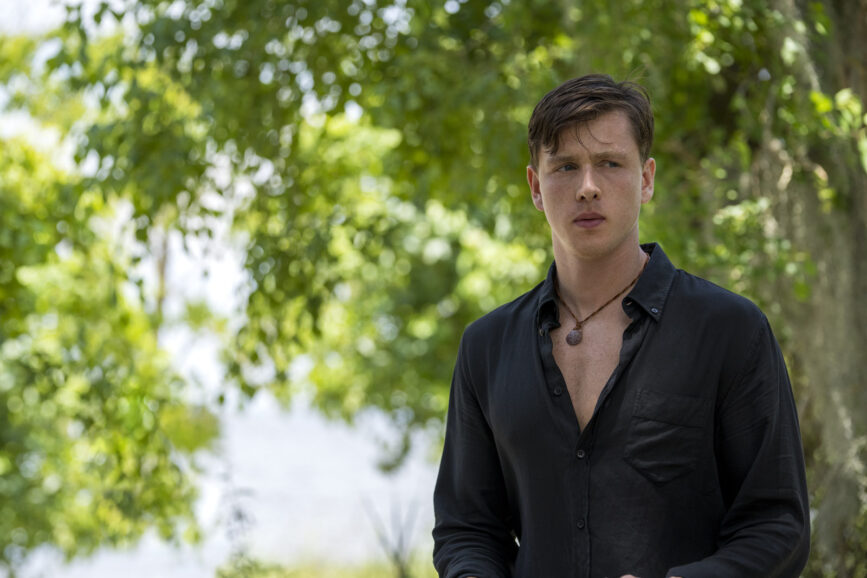
Often shooting with the Alexa Mini, Morgan knew instantly the Mini LF would be appropriate “not only due to its light weight, but because it would allow shooting large format. Transporting the viewer into Kyra’s experience of nature and that beautiful world by capturing an expansive field of view using a large format sensor was important.
“We never sat on the dolly, the dolly was always on a dance floor, moving freely in the space with a Ronin on it, or it was on an aero jib, a GFA crane or Technocrane. And as the camera package was so lightweight and flexible it was also used for drone work to capture the landscapes from the sky, headed up by operator Steve Koster.”
Morgan had ambitions of using a motion control rig to capture a 360-degree montage sequence which sees Kya’s love interest Tate teaching her to read. Playing out seamlessly in one shot, the sequence charts different time periods as they fall in love. “But after many weeks of research looking for a motion control rig small and light enough to be put into the set whilst working out how the construction team could build walls in the set that would work, we just couldn’t find a solution. Instead, we painstakingly used the Ronin to capture one shot and then measured everything before starting the next shot with the camera at the same height, like a Poor Man’s Process motion control shot.”
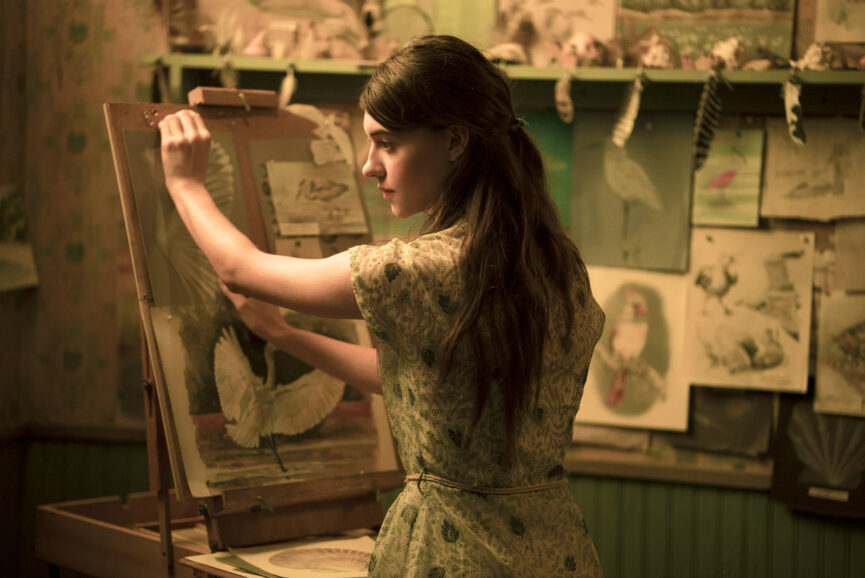
Morgan celebrates the dedicated filmmaking team behind such shots who had to “cope with crazy weather whilst performing at all times. If it wasn’t pouring with rain or we were sat in our cars waiting for lightning to pass, it was 90 degrees with 90% humidity and mosquitoes.” Key members of the crew included A Camera operator Mitch Dubin SOC ACO; B Camera Steadicam Grayson Austin; A Camera focus puller Bryan DeLorenzo; key grip Nick Leon and dolly grip Gerald “G” Austin “who was a whizz on the dolly.”
When shooting the striking sunset and the dawn scenes, the crew “prayed for sunny weather to achieve beautiful silhouettes of Kya searching for mussels.” Whenever the B camera crew were not filming along with the A camera crew, they would shoot “the most incredible nature photography” using mainly 80-200mm and 230-720mm zoom lenses.
“To really capture the beauty of the environment, they filmed birds, spiders, and alligators in their stunning habitat,” says Morgan. “Sadly, not a lot of it made it into the movie because it could have been a half hour production on its own. I just made sure all that contextual work was part of the film so we could really build Kya’s love for nature through the imagery.”
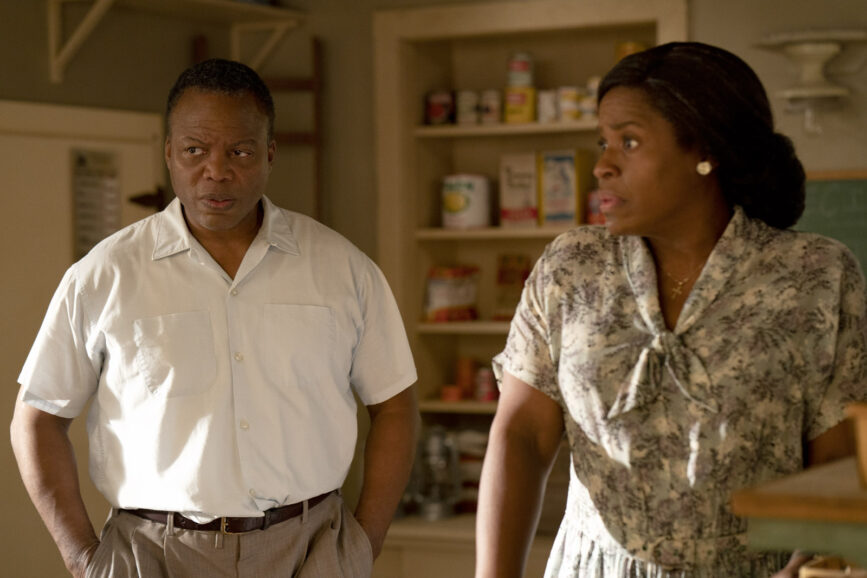
Communicating a love for nature
Research for a project with similar qualities to Where the Crawdads Sing provided Morgan with an understanding of the lens that would be capable of capturing the natural world in all its glory. During lockdown and prior to coming into the Crawdads fold, she asked Dan Sasaki at Panavision for guidance for an independent film she was prepping called The Desperate Hour which was about a woman who discovers there has been a shooting at her son’s school. Morgan was looking for lenses to suit the film’s heavy focus on the lead character as she ran through nature whilst on her mobile phone.
Morgan never shot the film because she had a baby, but when prep for Crawdads began, she remembered the conversations with Sasaki and reconnected with him. “Again, I would be shooting in nature, and I often wouldn’t be able to control and soften the natural light and make it beautiful for the lead actress.”
Morgan and Newman visited Panavision Woodland Hills to explore lens options – anamorphic, large format, spherical, and a low contrast prototype lens set Sasaki had previously mentioned he was developing that seemed a perfect fit for Morgan’s visual objectives.
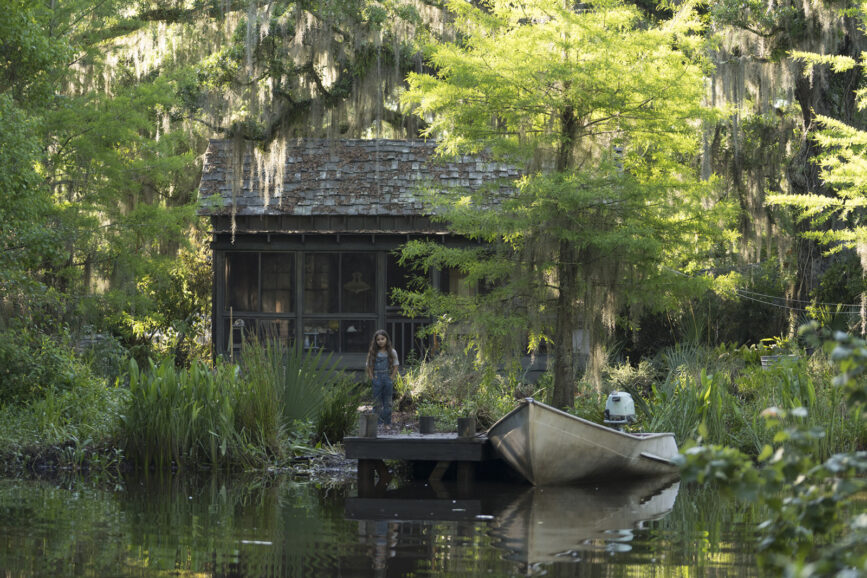
The filmmakers were united in their belief that anamorphic would not suit the film as Morgan “wanted to frame it 2.40 for the widescreen field of view but didn’t want the anamorphic squeeze. We also wanted the expansive nature that spherical large format lenses would offer. Dan’s Variel lenses were unique and had a lot of aberrations and artefacts which I’m always drawn to. They’re not technically perfect but have a lot of personality.”
Although impressed by the look the lenses produced, Morgan and Newman preferred an oval bokeh to the kidney shape they offered and wanted a warm flare rather than a magenta bias. “We didn’t want it to be cold or pink because this felt unnatural for the story being told. I also wanted to exaggerate the fall off and the distortion around the edges of the frame. As always, Dan made the adjustments according to our requirements to achieve just the look we wanted.”
Morgan frequently shot at the wider end of the spectrum, enjoying working with the 28mm and 40mm focal lengths most, “especially due to their three-dimensional fall off which offered a beautiful feeling of portraiture, where the characters really stood out from their environment.”
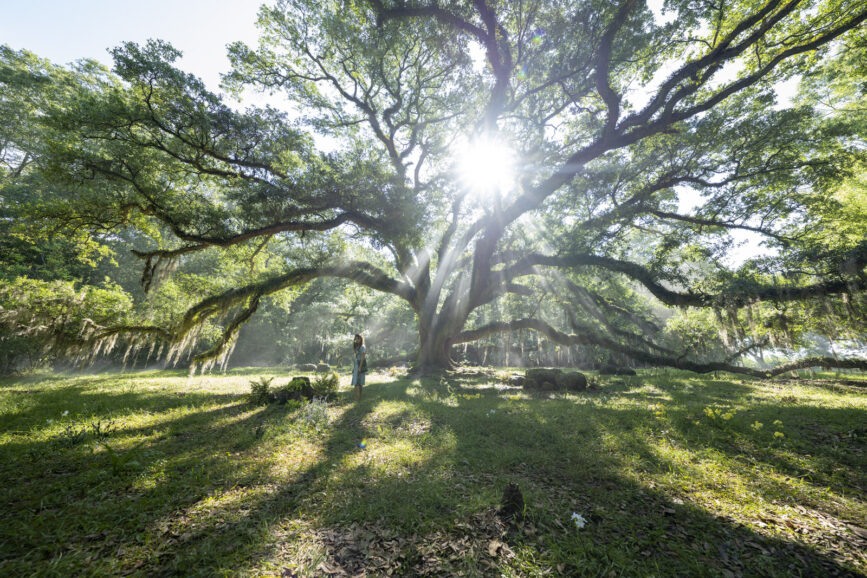
Being adaptable
Shooting much of the film in and around Louisiana bayous delivered an abundance of stunning backdrops, but also presented accessibility obstacles. “The lighting was very much based on naturalism and many locations were carefully chosen because of the path of the sun as it was difficult for us to bring in lots of lighting equipment. It was all about modeling the natural light and being as invisible as possible, often relying on the weather being kind to us,” says Morgan.
When it was possible to introduce a fly swatter rig, Morgan put up a 20 x 20 overhead and softened the midday sun with a light grid. The only occasion she leant away from naturalism and embraced more colour was for the scene when Kya and Chase go on a date. “Whereas her relationship with Tate is more innocent and romantic, there’s danger surrounding Kya’s love affair with Chase, which we explored with more coloured light.”
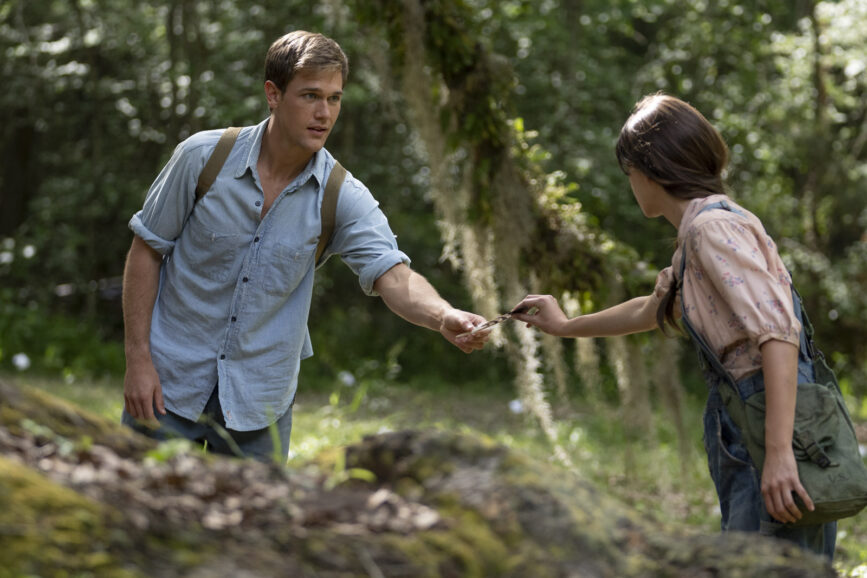
Morgan took inspiration from Robbie Ryan BSC ISC’s work for the opening of the sequence when Kya and Chase are on the beach by the fire. “I remember Robbie used fire for fire rather than supplementing it, or if he was, it was so invisible,” she says. “So, when Chase and Kya are sat around the fire, I just let the fire do all the work and used a couple of flame bars to supplement it. The warmth and energy of fire took us on this journey of embracing more colour in the light. We also used Poor Man’s Process when Kya and Chase drive to the motel, incorporating a lot of coloured lights and neon, and pulling focus on the rain, referencing Ed Lachman’s beautiful work on Carol.”
Many hours were spent on boats, scouting the bayous, discovering the best angles, and determining how scenes on the water could be shot with minimal gear. The crew also needed to find a beach with no modern life that could be seen around it. “This resulted in us working a lot on the north shore of New Orleans in two state parks,” says Morgan. “But I still couldn’t get equipment such as condors or large diffusion frames to the beach location.”
Referring to lighting the beach scenes as “run and gun” and “like shooting an indie movie”, Morgan also admits the extensive periods spent filming on boats whilst working out how to control the light were “intimidating at first. I had lead actress Daisy Edgar-Jones out on the boat who I wanted to illuminate in the most flattering way.
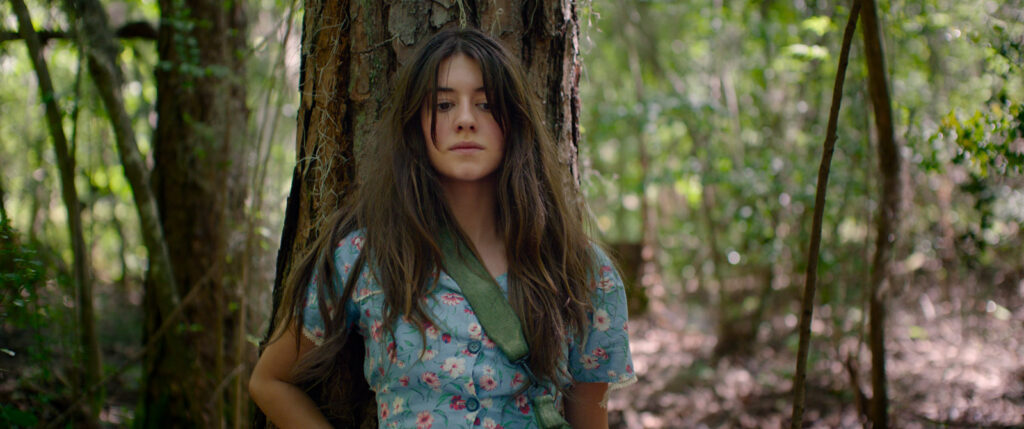
“What you don’t realise when watching the film is that behind Kya’s boat there is a convoy of vessels – two camera boats, hair and makeup, costume, craft service, a porta-potty boat, and a camera support boat with a DIT. Everything took a phenomenally long time because whenever you wanted to turn around to shoot the other way, you had to move about 10 boats.”
For the night-time shots on the water Morgan aimed to achieve “low contrast and pretty visuals, avoiding any areas falling into nothingness.” As the budget would not allow for using a barge on the water for large night-time lighting set-ups, they relied on a small boat carrying 4K pars and many Astera Titan LED tubeshidden in bushes. To achieve her lighting goals Morgan worked closely with gaffers Paul Olinde and Dan Riffel.
“As it’s so beautiful there, we didn’t want to lose any detail at night and always wanted information in the background. But the inaccessibility made this difficult, so we sent crew members deep into the trees to hide Tubes far away to hold depth in the image.”

Despite careful scheduling and planning to shoot in the spring to avoid hurricane season in the summer, the hurricanes unfortunately made an early appearance. Production designer Sue Chan and the art department had allocated time to change over the town or the cabin for each period the story incorporates – the ‘50s, ‘60s, ‘70s, and present day – but when the area received the highest level of rainfall for years this proved impossible to accomplish.
“After building Kya’s cabin at Fairviewstate park, we looked at the path of the sun and how it would relate to the sequences in Kya’s front yard and garden, and the lagoon in front of her cabin. But then we had to shut down for a couple of days because our sets were flooded,” says Morgan. “Kya’s cabin and the garden, which was so beautiful when we first started, had turned into a mud pit after the first week. We had to keep putting down location boards with dried leaves on top to hide the mud bath.”
The initial plan for the cabin was to place three lifts with Arrimax 18Ks around the set, but instead dimmed down ARRI 360s were used. “The throw from the 360’s worked perfectly, and the source felt more natural than the 18Ks. We were working at such low light levels to hold information in the background that the 18Ks just couldn’t hold any more wire to get them where we needed them to be”.
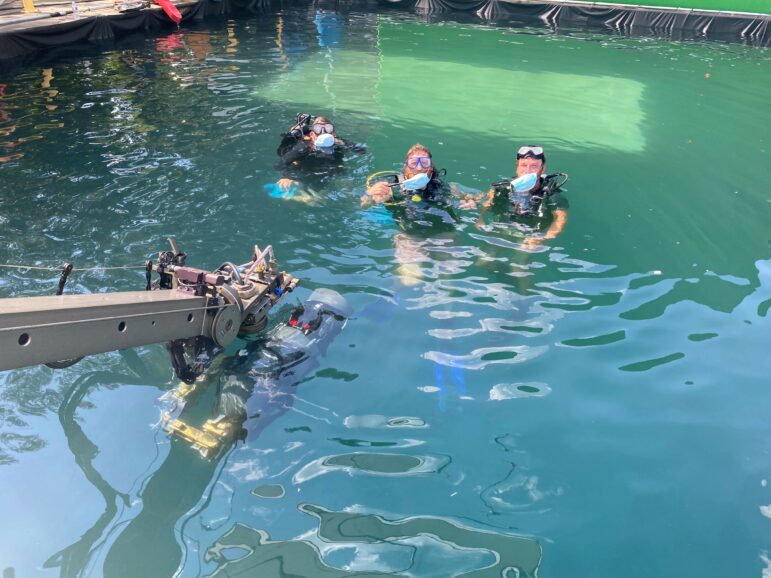
The day exterior work at the Firetower was achieved by building a set at a racing car facility. Initially, the plan was to build in on stage and surround the set with green screen, but Morgan was unsure of this approach after creating a similar set up on A Quiet Place Part 2.
“We shot a scene on stage with Millie on top of the Silo at dawn,” says Morgan. “Despite surrounding the set with large soft sources and a big overhead soft box, it proved a tricky comp in VFX. I wanted these sequences to feel real and dangerous height wise, so it was important that the VFX was as seamless as possible.”
The final approach was to build the set outside and surround it with 40×40 green screens on Manitous that were adjustable to the shot as well as using a couple of fly swatters with light grid on to control the sun. “The natural daylight provided a much better base for the VFX work than artificial lighting on set ever could.”
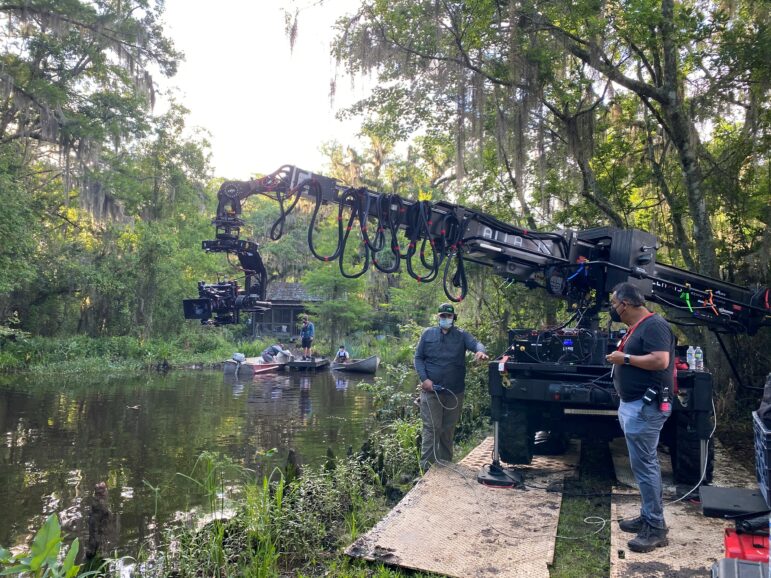
The underwater sequences were captured in an exterior tank on the north shore of New Orleans which was adapted using different rags to suit each type of scene. “For the romantic underwater kissing scene, we put white on the walls so the light would bounce, and the water would look turquoise. We top lit with an 18K Arrimax and created beautiful rays of light,” says Morgan. For underwater scenes taking place in swampy water, they turned the rags grey and dyed the water in the tank green.
Following a lengthy search for a location suitable for the present-day courtroom scenes, a building with the required two-tiers was discovered. But modifications were needed, and Morgan pleaded with Chan, who was working within a limited budget, to add wood paneling and a floor, and paint the walls a dark blue. Morgan also requested large sconces be put on the wood panelling to reflect off the wood and provide a warm colour contrast to the cool window light.
Satisfied with the courtroom transformation, Morgan then encountered a lighting hurdle – the sun path went straight through the windows, and the direct sunlight shining in would cause matching issues on the day. Key grip Nick Leon, devised a solution comprising a huge rig on chain motors outside the window which allowed a diffusion frame to be positioned to soften and reduce the light coming in. “Unfortunately, the sun only emerged on one of the days we were there, so we only used it once,” says Morgan. “The rest of the time it was stormy with lots of lightning, and we just had to sit and wait for them to pass.”

Bright sparks
Nature was again one of the major factors when Morgan worked with Company 3 colourist Natasha Leonnet from the prep stages and many conversations centred around the strong green hue that would be present in so many of the images. Morgan did not want to create a LUT “that had a lot of warmth in it because the greens would become very yellow and feel very digital looking.” She wanted the greens to be “very naturalistic and feature more blue, in the way they used to look when we shot on film. If I think back to the movies I grew up watching, the greens were more desaturated and darker than you see now in productions shot with digital cameras.”
Leonnet helped create a neutral LUT that “felt filmic and didn’t have any bias towards the warm end of the spectrum.” The production and costume designers were also involved during the testing stages when the LUT was being built. “Sometimes designers will do a lot of work and then when you put a LUT on the camera and the colours don’t come out the way they are intended,” highlights Morgan. “We didn’t want something that would artificially affect the image, so it wasn’t true to the eye.”
Leonnet and Morgan also explored possible solutions to resolve a problem that can be faced when grading a P3 deliverable for a theatrical release. “When monitoring on set, you are viewing 100 nits on a backlit monitor,” says Morgan. “So, when you get into the DI everything’s projected at 14 foot-lamberts, the image has half the brightness. Of course, you are exposing with scopes, but I tend to light the image, so it sits on the lower end of the spectrum.”
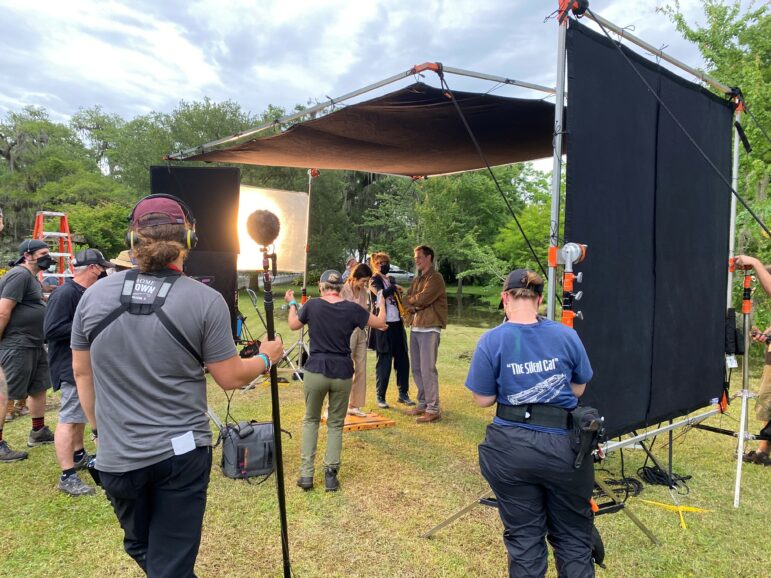
Morgan wanted to ensure the contrast was soft for the night work and there was a lot of information in the shadows. “I wanted to have a nice thick negative so when I got into the DI, I had plenty of information in the low end,” she says. “I’d heard Roger Deakins, who also does post work at Company 3, turns down the brightness on all the monitors on set, so they match to 14 foot-lamberts. But if I went down that road, it would have complicated dailies and I would have had to ensure the pipeline was correct for the studio execs watching the footage.”
Instead, Morgan opted to build two LUTs – a daytime LUT and a night-time LUT which was the same colour but balanced to 48 nits. “Removing half the brightness forced me to put more light in the image. When we were all looking at that 48-nit LUT, the image would be much darker, so I would expose it in a healthier way. And then when I got into the DI, my negative was really thick and whenever I wanted to bring out anything in the shadows or lift anything up, I had no issues with muddiness or graininess – there was lots of information there.”
The work carried out in the grade also saw Leonnet balance colours and dial back any overpowering elements in the background. “We also worked a lot on skies because unfortunately many were white and flat, with no texture, and we had to fight to add some film grain in post to tie in with the period nature of the movie,” says Morgan.

The large, glorious tree that plays a starring role in one of the film’s most striking frames, dwarfing the characters under it, was another element Morgan was adamant should be included. Much like the film’s protagonist, who never gave up, the cinematographer’s determination paid off. “It was our first day of production and the ginormous beautiful tree was well out of the zone, but I pushed for us to shoot it. I’m so glad we fought for that because it was such an epic tree and powerful image in the film,” says Morgan.
“When making movies, you realise some things are really worth pushing for, from scheduling through to visually stunning gifts from nature such as the tree. You can’t give up and that’s why Olivia was such a great director to collaborate with – she always fought for what was best for the movie.”

